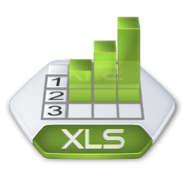Statistics
Course objectives and method
Course material
Downloads
Everytime the MS Excel symbol is displayed on the slides, an MS Excel file will be shown in class in order to constract a graph, analyze data, run a statististical test, etc. You can download the MS Excel files here.
Students who are not familiar with MS Excel (do they still exist?) can download a free tutorial written by Chris Albright here.
Notes
Upon request of some students, extra notes used in each session.
Session 1
Temperature: Formula for Farenheit and Celsius Conversions
- C = 5/9 (F-32)
- F = 9/5 C + 32
Session 2
- The MS Excel file to illustrate that the covariance is affected by the units and the correlation is a unitless measure, can be downloaded here.
- The MS Excel file to illustrate the rules-of-thums (sigma intervals) on the saraly database can be downloaded here.
Session 3
Homework: For one or another reason, the excel file of the homework P04_68.xls is not available on the website of the book, so you can download it here.
Exercise 4.11: The MS Excel file used to calculate the average and standard deviation for exercise 4.11 can be downloaded here.
Session 4
Normal table: A normal table can be easily constructed using MS Excel. The empty table on page 25 of the slides can be filled using the simple “NORMDIST” function in Excel. Download the table here.
- One-sigma: =NORMDIST(53,50,3,1) - NORMDIST(47,50,3,1)
- Two-sigma: =NORMDIST(56,50,3,1) - NORMDIST(44,50,3,1)
- Three-sigma: =NORMDIST(59,50,3,1) - NORMDIST(41,50,3,1)
Session 5
Central Limit Theorem: Roll the dice and see that the central limit theorem is true. In class, I artificially illustrated this on the blackboard with 2 dice and 36 throws, but on the following website, you can do it with up to 5 dice and 10,000 throws. Go to http://www.amstat.org/publications/jse/v6n3/applets/clt.html
Session 6
Students t-distribution: The table used in class can be easily constructed and modified using MS Excel. Download the table here.
Confidence intervals and hypothesis testing are everywhere. Don’t go search the internet because you will be overwhelmed by sites and references. A very simple yet illustrative example is given at the following site: Go to http://www.unc.edu/~blopes/files/stat11spring03/Files/HypothesisTesting.pdf.
Apparently, one picture was not very clear on the slides, so you can download it here.
Session 7
Statistical Process Control: SPC is hot. Just search the internet, and you will find many sources on SPC. Currently, we are trying to transform SPC (Statistical Process Control) to SPC (Statistical Project Control). In other words, controlling and monitoring the performance of projects (building bridges, towers, IT projects, ...) using the principles borrowed from Statistical Process Control combined with Earned Value Management. Interested, follow us on our Twitter account, or visit EVM Europe.
Session 8
No extra downloads available. Good luck with the exam!

